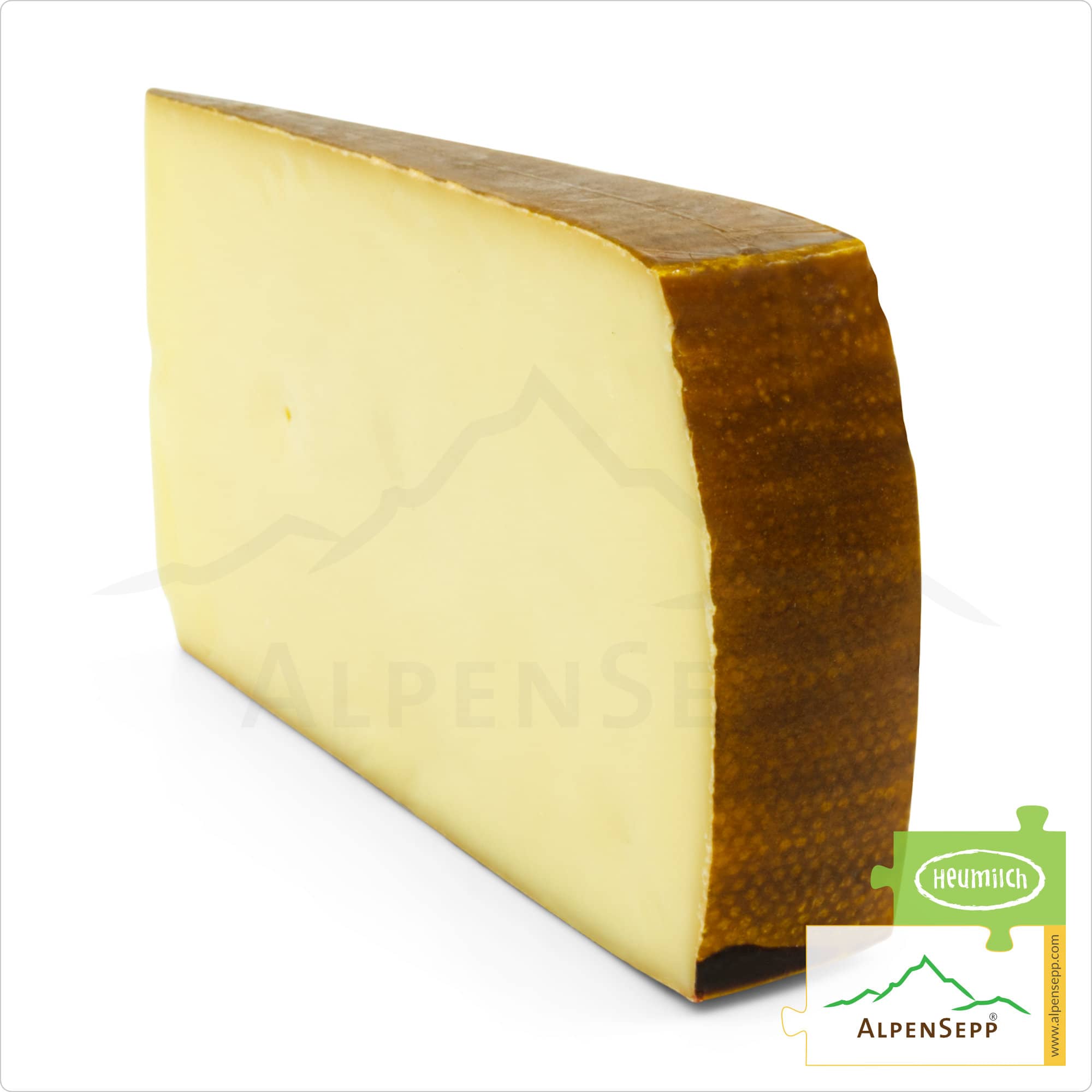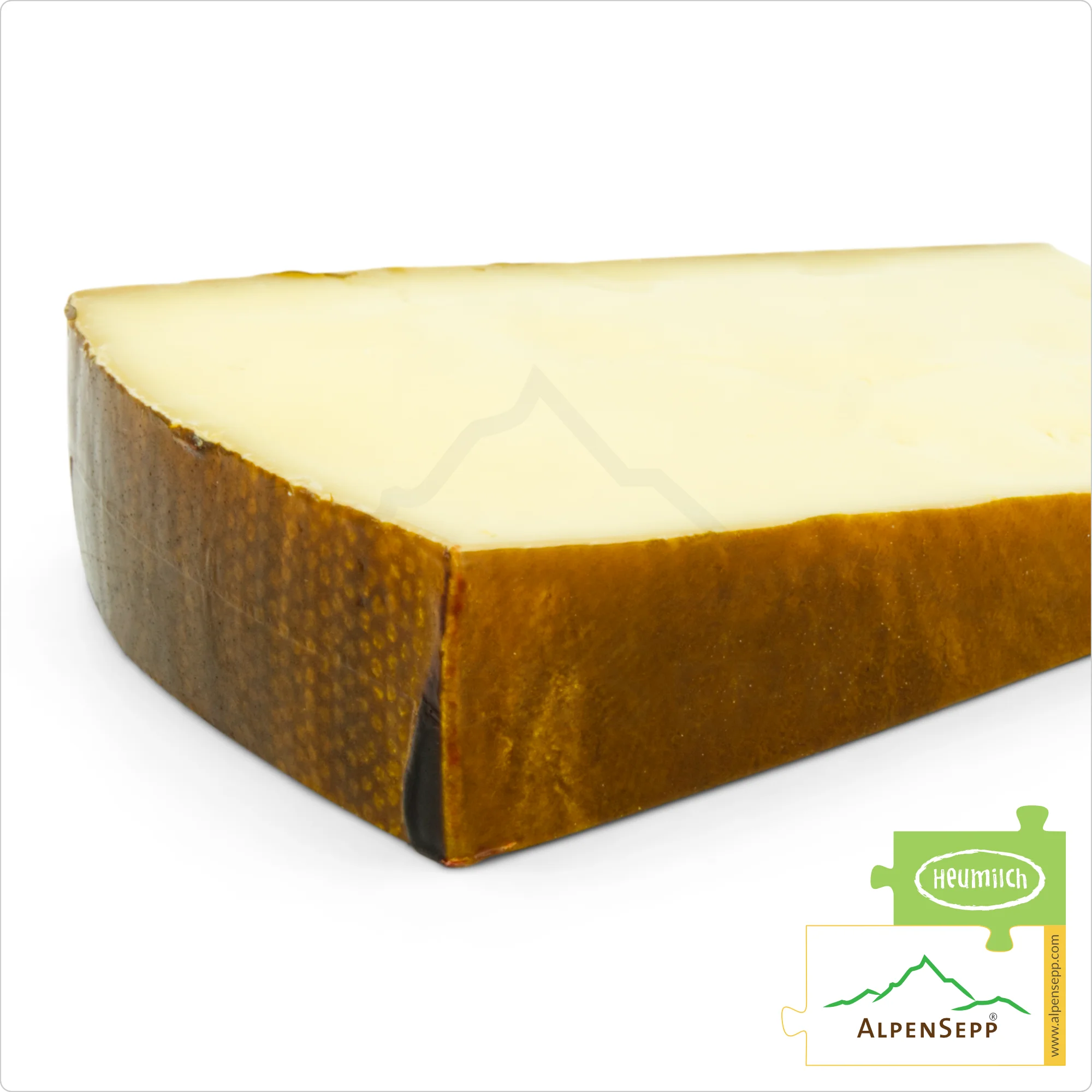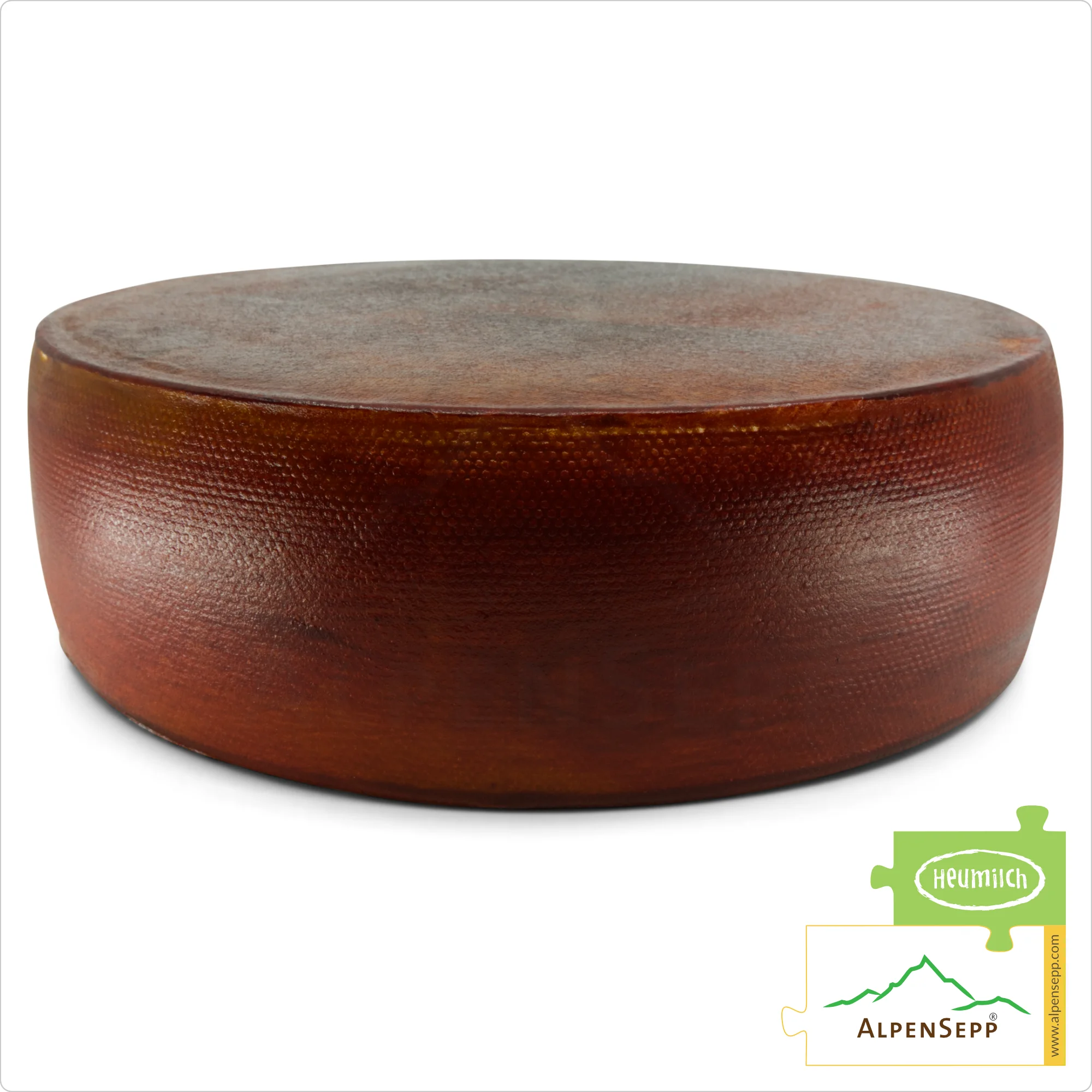Hard cheese | Mountain cheese
Semi-hard cheese

Original price was: € 243,24.€ 218,92Current price is: € 218,92. (incl. VAT)
Base price: € 30,03/kg
The Hay Milk Wine Cheese Wheel by experienced cheesemaker Christof Schneider is a true delicacy that combines top quality and exceptional taste. This special cheese is based on carefully selected semi-hard cheese wheels from various renowned dairies in the Bregenzerwald, known for their traditional cheese craftsmanship.
After selection, the cheese is taken to the Berchtold family’s cheese cellar, where it is carefully nurtured and aged. A unique feature of this wine cheese is its treatment with Austrian red wine.
The rind of the cheese is regularly rubbed with red wine during the aging process, giving it a distinctive, spicy wine aroma. This unique process ensures the cheese stands out not only in taste but also in appearance – with a cream-white, holey cut surface made of semi-firm dough.
The wine cheese wheel is made from the finest hay milk, which not only imparts its full-bodied flavor but also guarantees high quality and sustainability. Hay milk comes from cows fed exclusively with fresh grass and hay, making the cheese particularly natural and aromatic.
Additionally, the cheese is lactose-free, allowing even people with lactose intolerance to enjoy this exquisite product.
Lactose-free aged cheese: The natural milk sugar in our hay milk cheese is broken down by lactic acid bacteria. Result: lactic acid plus excellent flavor and aroma development.
With its unique taste and top-quality production, this wine cheese is a true delight for anyone who appreciates premium cheese.
Wine cheese is rubbed with the best Austrian red wine during aging, giving it a typical flavor and a dark red to almost black-red rind thanks to the wine treatment.

Our wine cheese belongs to our family of mild cheese varieties featured in our shop.
Our wine cheese wheel gains a spicy wine aroma through careful manual care, where its rind is rubbed with the finest Austrian red wine. The cheese’s cut surface is cream-white, beautifully holey, and firm.
This exquisite wine cheese with soft melting, smooth texture and occasional cherry-sized holes is a favorite of many cheese lovers. Its mild and distinctive taste and soft texture also make it a favorite among locals and guests.
Its distinctive aroma is achieved through manual care, as we massage its rind with premium Austrian red wine.
The characteristic properties of wine cheese are significantly influenced by the high-quality alpine milk, its ingredients, flavor, and consistency, as well as the Vorarlberg alpine flora.
This results in the exceptional quality of alpine cheese.
Further interesting details on semi-hard cheese can be found on Wikipedia.
Cheese has been produced and aged in Vorarlberg’s alpine and valley dairies since the early 20th century.
The production method of “fat cheese” (as opposed to low-fat cheese such as Montafon’s Sura Käs) originally came from Switzerland and quickly spread in the Bregenzerwald region.
Semi-hard cheeses are made from natural (non-thermized, pasteurized, or centrifugal-separated) (hay milk) with at least 45% FDM.
Thanks to small-scale farming, which supplies the raw materials, and traditional alpine dairy practices, the artisanal production and traditional care of high-quality cheeses have been preserved to this day.
Further interesting details about semi-hard cheese can be found on Wikipedia.

The wine cheese has occasional cherry-sized holes. Its cut surface is cream-white, beautifully holey, and firm.

The wine cheese rind is regularly treated with Austrian red wine, making it red. Due to the sticky wine coating, it is not intended for consumption.

Wine cheese is aged for about 4 months in our cheese cellar before it is ready to enjoy.
The specialty of wine cheese lies in its mild, unique cheese flavor paired with wine notes.
Wine Cheese Intensity
How mild or spicy is the cheese? Rated on a scale from 0 (mild) to 10 (spicy).
Wine Cheese Texture
How firm is the cheese? Rated on a scale from 0 (soft) to 10 (firm).
Wine Cheese Aging Time
How long was the cheese aged? Rated on a scale from 1 to 12 months.
| Milk: | 100% from silage-free hay milk |
| Cheese Type: | Lactose-free semi-hard cheese (SH) |
| Aging Type: | Lactic acid and/or fermentation aging / surface aging in a cheese cellar with salt care + wine treatment |
| Flavor Profile: | Mild, smooth, soft-melting |
| Aging Duration: | 3 months |
| FDM: | minimum 45% |
| Fat Content: | approx. 22.5% |
| Allergens: | Apart from milk components, no other allergenic potential |
| Lactose: | Not present |
| Rennet: | Natural, animal rennet |
| Salt: | Iodine-free table salt |
| What defines the cheese – the wine cheese character? | Particularly soft cheese with a soft-melting cheese texture |
| What does the wine cheese taste like? | Full-bodied, soft-melting cheese-wine aroma |
| How does it feel in texture? | Semi-firm cheese with soft-melting cheese texture |
| What is the color of the wine cheese? | Whitish to yellowish dough, highly seasonal |
| What does the cheese dough smell like? | Pleasant cheese scent combined with fine wine nuances |
| What does the hole pattern look like? | Occasional cherry-sized holes |
| How is wine cheese best enjoyed? | On sandwiches, for breakfast, or simply sliced for dinner. |
| What indicates improper aging – lower quality? | The cheese should be semi-firm but not sticky. |
If you plan to store large pieces or a whole cheese wheel for more than 2-3 weeks, we recommend using a tea towel.
Take a clean tea towel, soak it in saltwater (just add a bit of salt), wring it out, and wrap the cheese in the damp towel. This process should ideally be repeated every 2-3 days.
If the cheese develops a slight white coating or spots, it is usually salt or protein crystallized due to temperature differences. Simply wipe these spots away.
The use of aluminum foil is possible (though not recommended) if supplemented with many small holes for airflow.
Do not store or cut cheese on boards, wood, or surfaces previously used for bread. The yeast residues in bread cause the cheese to mold quickly.
Proper storage of wine cheese
If you want to storeThe alpine cheese is best located in a cellar with high humidity. » More info large pieces or a whole wine cheese wheel more than 2-3 weeks, we recommend the use of a tea towel. To do this, take a clean tea towel, soak it in salted water (just add a little salt), squeeze it out and wrap the cheese with the damp cloth. Ideally, this process is repeated every 2-3 days.
If the cheese turns white or stains it is usually the salt or proteinCasein is a constituent of the protein (protein) of cow's milk, which is obtained for cheese production. » More info that crystallizes due to the temperature difference. These places are easy to rub off.
The use of aluminum foil is possible (but we advise against it) if it is supplemented with many small holesThe large round holes (round holes, fermentation holes) are caused by fermentation gases of bacteria (for example, the propionic acid bacteria in Emmentaler, etc.). » More info because of the air supply.[vc_message message_box_color=”danger”]
No bread contact – yeasts
Please never place the cheese on boards, wood, documents, etc., where bread used to be. The yeast residues of the bread quickly make the cheese moldy.[/vc_message]
| Weight | 8,1 kg |
|---|---|
| Brand | AlpenSepp® |
| Country of origin | Austria |
| Cheese maturing time | 3 months |
| Ingredients | Cow's milk, cheese-making, natural lab, iodine-free table salt |
| Kind of cheese | |
| Name of cheese | Wine cheese |
| Taste Intensity | mild |
| Weight | |
| Type of cheese | Traditionally hand-made Austrian semi-hard cheese from silage-free raw milk (hay milk) |
| GTIN | 9120022282114 |

When you visit any web site, it may store or retrieve information on your browser, mostly in the form of cookies. Control your personal Cookie Services here.
Reviews
There are no reviews yet